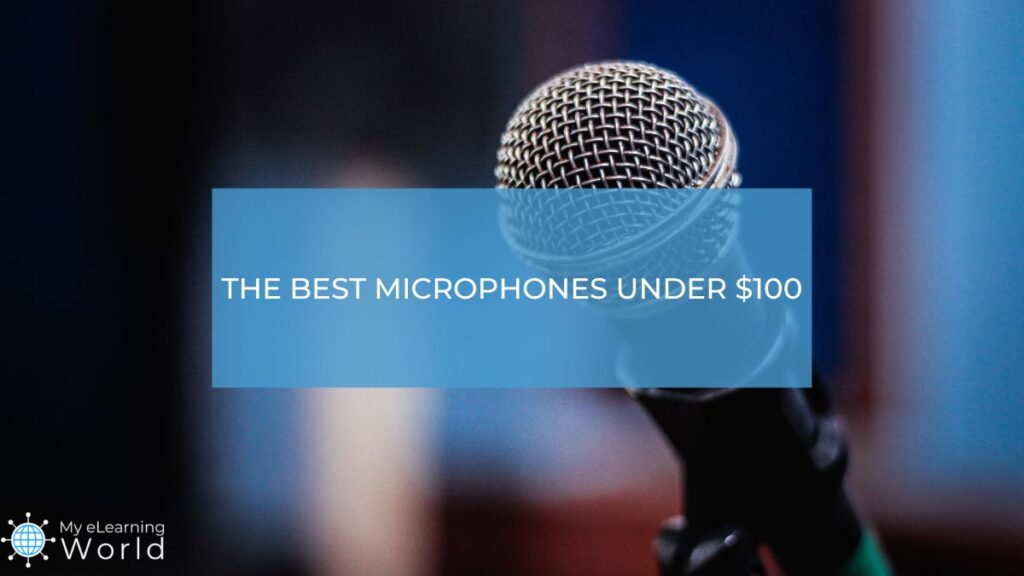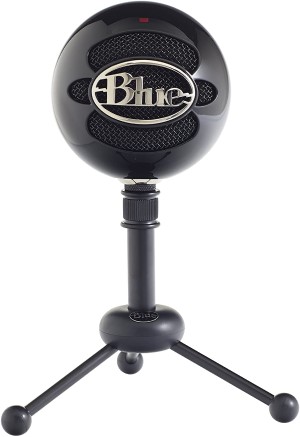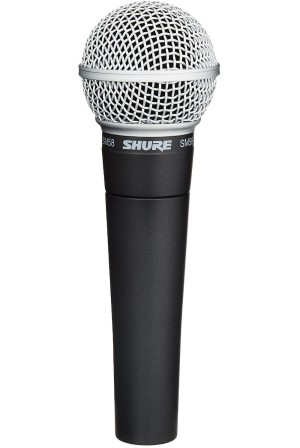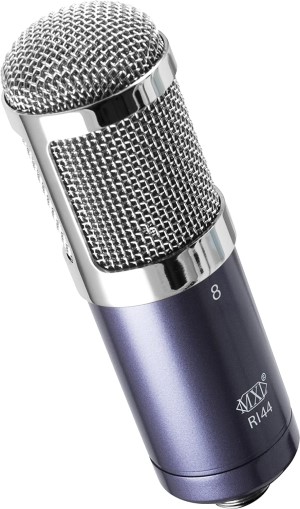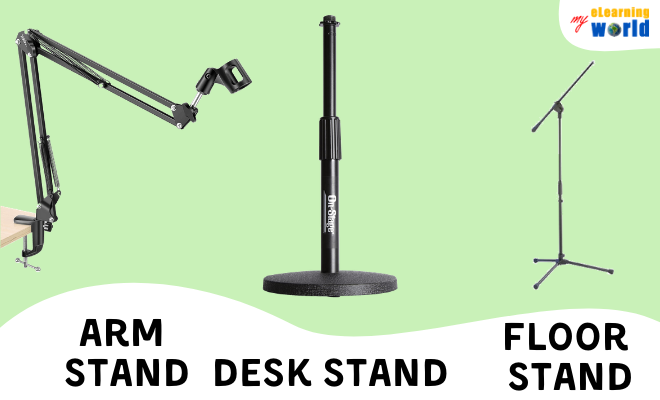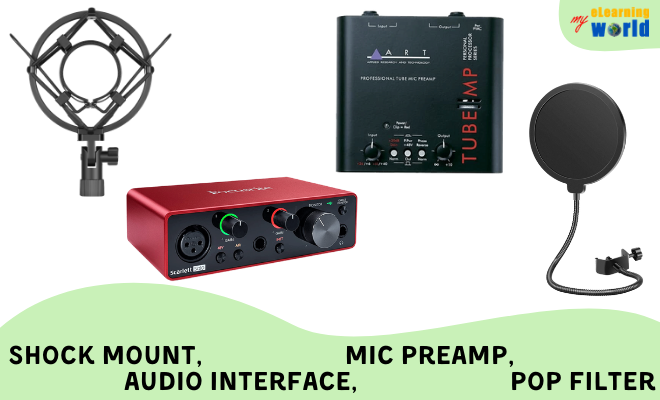Whether you’re recording voiceover work for an online course, audio for a video, or even music instruments, a budget microphone could be all that you need to get a professional-quality finished product. These days, there are some great microphones under $100 that can be used for everything from studio recordings to live performances.
Of course, not all cheap microphones are up to par, so it’s important to do your homework before making a purchase. To help you out, I’ve compiled a list of the best budget-friendly microphones I’ve tried over the years in my home studio as an eLearning creator. I’ve tested and reviewed dozens of affordable budget microphones since originally putting together this guide back in 2021 (and all throughout my nearly 20 years in the industry), and now, I’ve fully updated it for 2023 to include a curated list of the top cheap microphones on the market today.
I made my picks based on a range of factors, including audio quality, durability, ease of use, and of course, cost (click here to learn about our entire Editorial Process & Methodology for product reviews).
Quick Pick for the Best Budget Microphones Under $100
Don’t feel like reading the full rundown of budget microphones? Here are my quick picks for the very best budget mic under $100:
My Top Pick
Blue Snowball
What’s inside?
- Choice of omnidirectional or cardioid polar patterns
- 40 Hz to 18 kHz frequency response
- 44.2 kHz/16-bit sample rate
- Gloss black spherical design 325 mm circumference
- USB connector
Killer features: Low price, excellent style, and performance
The Blue Snowball is my top pick for a condenser mic under $100. This budget microphone has a beautiful, classy, retro look. The polar pattern can be changed to allow omnidirectional pickup of sound coming toward the device from every direction or a more-focused cardioid pattern that does not pickup sound from behind the microphone.
Also Great
Shure SM58
What’s inside?
- Unidirectional polar pattern
- Has an on-off switch
- 50 Hz to 15 kHz frequency range
- Classic black color
- XLR connector
Killer feature: Very durable
The Shure SM58 is my choice of a cardioid dynamic microphone under $100. The pickup pattern is able to capture sounds from in front of the device and not those sounds coming from behind it. Roadies love this budget microphone because it is so durable. You can drop it, swing it around your head on its cable and it will probably still work. Shure products have been the music industry standard for decades.
Also Great
MXL R144
What’s inside?
- Figure-8 bidirectional polar pattern
- Compact size
- Captures a smooth rich midrange sound
- High sound pressure level (SPL) capability
- Comes with a shock mount
Killer feature: Small size fits almost anywhere
The MXL R144 is my choice of ribbon mic that is also great. This budget microphone costs right at $100, and among the ribbon models, its price is much cheaper. The bidirectional polar pattern picks up both the instruments being recorded and the room sound. The high SPL makes it a good choice for a microphone used to record loud instruments like brass or amplified electric guitars. The shock mount helps prevent damage to the product.
The Full List of My Favorite Budget Microphones Under $100
I separated my budget microphone reviews into four categories:
- Large-Diaphragm Condenser;
- Small-Diaphragm Condenser;
- Dynamic;
- Ribbon.
I also indicate the type of connectors that the microphones have, which can be XLR, USB, and XLR plus USB.
Each category of mic is designed to use for a specific purpose. If you need a refresher about the differences between these four categories, watch this video:
 |
Professionals will appreciate this model. Category: large-diaphragm condenser [XLR]
|
Amazon →SweetWater → |
 |
For those who want to record warm sounding vocals and to speak directly into the mic. Category: large-diaphragm condenser [XLR]
|
Amazon →MXL → |
 |
Suitable for professional recording studios and home studios. Category: large-diaphragm condenser [XLR]
|
Amazon →AKG → |
 |
For podcaster or someone who make voice-overs using software. Category: large-diaphragm condenser [USB]
My choice among microphones under $100
|
Amazon →Blue → |
 |
Good budget microphone for those who need a compact portable device. Category: large-diaphragm condenser [USB]
|
Amazon →SweetWater → |
 |
Perfect for gamers and live streamers. Category: large-diaphragm condenser [USB]
|
Amazon →Razer → |
 |
For studio recording of instruments. Category: small-diaphragm condenser [XLR]
|
AKG → |
 |
Good budget microphone that can be used for voice-overs, vocals, and recording instruments Category: small-diaphragm condenser [XLR]
|
Amazon →Guitar Center → |
 |
An improvement over the built-in mics found in laptops and still is small enough to be portable. Category: small-diaphragm condenser [USB]
|
Amazon →SweetWater → |
 |
This budget mic is terrific for podcasting. Category: small-diaphragm condenser [USB]
|
Amazon →SweetWater → |
 |
An attractive model for doing podcasts. Category: small-diaphragm condenser [USB]
|
Logitech→ |
 |
Good for almost every live music performance and live recording use. Category: dynamic [XLR]
My choice among dynamic microphones under $100
|
Amazon →SweetWater → |
 |
Made for vocalists giving live performances. Category: dynamic [XLR]
|
Amazon →Sennheiser → |
 |
Best budget microphone recommended for Garageband users. Category: dynamic [USB + XLR]
|
Amazon →SweetWater → |
 |
Good starter choice for voice-overs and podcasts Category: dynamic [USB + XLR]
|
Amazon →SweetWater → |
 |
Good choice for those with devices that have a USB-C input. Category: dynamic [USB + XLR]
|
Amazon →SweetWater → |
 |
This device helps broaden the tonal palette of instrument recordings. Category: ribbon
My choice among cheap ribbon mics!
|
Amazon → |
Best Low-Cost Condenser Mics Under $100
Dynamic microphones are popular for live performers to use during shows because of their rugged construction; however, for recording in a studio, especially for vocals, a condenser one is preferred. Large-diaphragm condenser models are a good choice for recording vocals because they capture every nuance with sonic details.
Large-Diaphragm Condenser Microphones under $100 with XLR
These microphones are used with an audio interface or mic preamps so they are suitable for both beginners and professionals.
1. Audio-Technica AT2020
Audio-Technica has always made excellent condenser microphones. Condenser mics need an external power source (“phantom” power) to operate, which comes from the mixing board or preamp through the XLR connector cable.
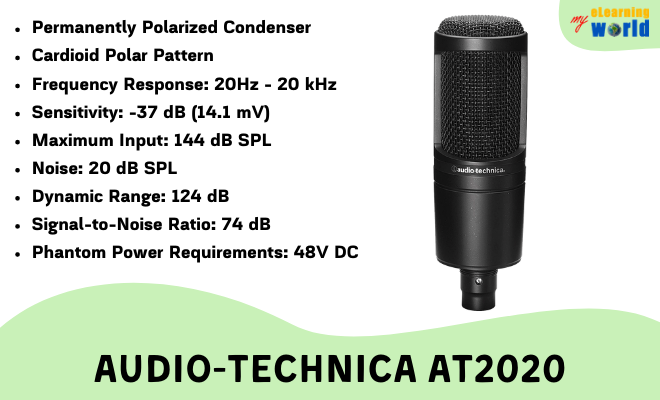
Features
This cardioid condenser microphone, priced at a modest $99, is a gem for those on a budget. It offers studio-grade clarity, ensuring every nuance of your voice is captured, whether it’s for an eLearning module or a voiceover gig.
The cardioid pattern is a lifesaver, focusing on sounds directly in front and minimizing those pesky background noises.
And trust me, its performance rivals many of its pricier counterparts. For those setting up a home studio without splurging, the AT2020 is a reliable and value-packed choice.
Killer feature: Captures the full frequency range of human hearing.
Pros
- Has a very wide frequency range of 20 Hz to 20 kHz.
- Noise level 20 dB.
- Front of mic is marked.
- Cardioid polar pattern focuses sound pickup to the front of the model.
- Comes with a mount and a 5/8 to 3/8 inch stand adapter
Cons
- Needs phantom power to work.
- Will not work with an XLR to USB cable connector.
- Will not work with a USB sound card.
- Needs to have a USB audio interface device (sold separately) to work with a computer.
- Does not come with a cable.
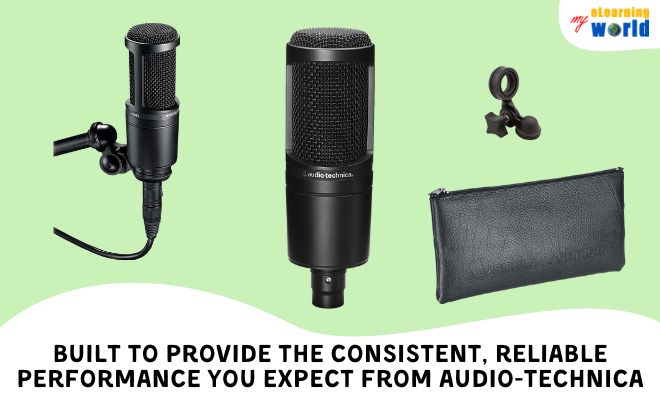
Best for: Professionals who are willing to invest in XLR microphones are the ones that will appreciate this model. It is not suitable for hobbyists due to the need to also buy an XLR cable and an audio interface device. There are lower cost solutions for those you simply want to record voice-over to make YouTube video.
This video, produced by Podcastage, reviews the Audio-Technica AT2020.
The reviewer likes the build quality and says it is all metal, which feels substantial. The mount and adaptor are metal as well. The cardioid pickup pattern focuses on sound coming at the mic from the front and picks up less from other directions. The reviewer tests how the model captures voice at different distances and how it handles different volume levels of music.
Buying Options
2. MXL V67G
Having worked with numerous microphones over the years, the MXL V67G stands out, especially for its price range. Its sensitivity ensures that every detail of a voiceover is captured, which is crucial when creating eLearning content where clarity is paramount. The vintage design is a nice touch, but it’s the performance that truly impresses. For those in the eLearning industry or voiceover artists working from a home studio, this microphone offers a fantastic balance of quality and affordability. It’s a tool that can elevate the quality of your recordings without breaking the bank.
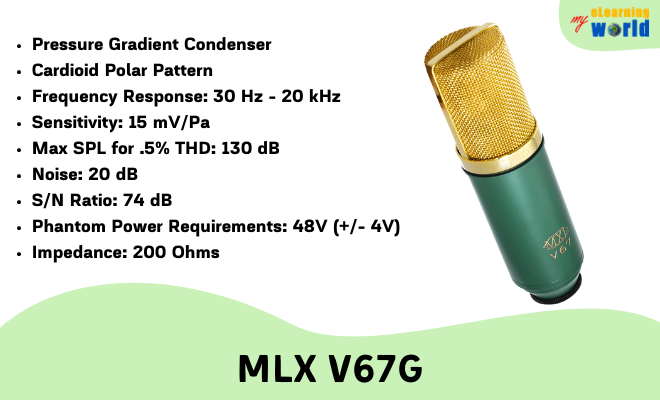
Features
This condenser mic is designed for recording vocals. It is a solid-state model made with Class A FET circuitry and a transformer that captures a clear, warm sound. It has a very attractive look with a distinctive vintage-style body and a gold-plated round grill.
Killer feature: The sound is described as “old-school” tube microphone mellow.
Pros
- Frequency range of 30 Hz to 20kHz.
- A good value for the price.
- The vintage style is very attractive.
- Comes with a leather carrying pouch.
- Comes with a clip and a stand adaptor.
Cons
- Requires phantom power to operate.
- It is very easy to put dents in the grill.
- This device performs badly in humid environments.
- Somewhat fragile.
- Lousy customer service from the manufacturer in China.
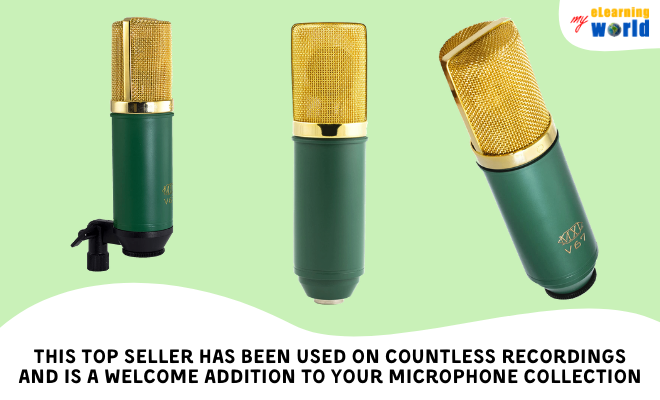
Best for: This condenser microphone is suitable for those who want to record warm sounding vocals and is best when used for singing of speaking directly into the mic.
This review, produced by Podcastage, is for those who do not mind listening to an annoying audio nerd who is bleeped out for swearing every few seconds.
The reviewer tests it to demonstrate the cardioid polar pattern and show how little background noise it picks up. He shows how audio changes when moving its capsule around and how it sounds when speaking right into the mic and from four feet away. He records some awful singing and bad guitar playing 🙂
Buying Options
3. AKG P120
Priced at a reasonable $99, this budget-friendly microphone offers a blend of quality and affordability that’s hard to find. Its frequency response ranges from 20 Hz to 20 kHz, ensuring a broad spectrum of sound capture. The maximum SPL of 150 dB and a sensitivity of 24 mV/Pa highlight its capability to handle varied recording scenarios. What truly stands out for me is its low-mass diaphragm, which delivers a clear sound with precise sonic details. This is crucial when you’re recording voiceovers where every nuance matters.
Whether it’s for vocals, speech, or instruments, the AKG P120 provides a clarity that’s essential for professional recordings, especially in home studios. For those in the eLearning industry or anyone venturing into voiceover work, this microphone is a solid investment that won’t disappoint.
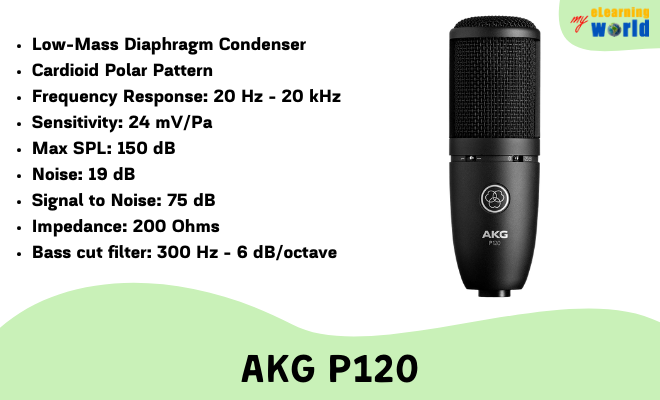
Features
AKG P120 has a unidirectional cardioid polar pattern. It picks up the full range of sounds that humans can hear. It can be used to record a very loud sound source of up to 150 dB without adding any distortion, such as a loud amplified electric guitar. It has a rugged all-metal body and is built well to record music.
Killer feature: It has a built-in bass-cut filter and a switchable attenuation pad.
Pros
- Very high maximum SPL of 150 dB.
- Frequency range 20 Hz to 20 kHz.
- Noise Level 19 dB.
- Comes with a bass-cut filter and a switchable attenuation pad.
- Comes with a clip.
Cons
- Requires phantom power.
- Work best when used with a shock mount (not included).
- Like all condenser microphones, it is bit fragile.
- Does not come with a carrying pouch.
- Need to buy an XLR cable separately.
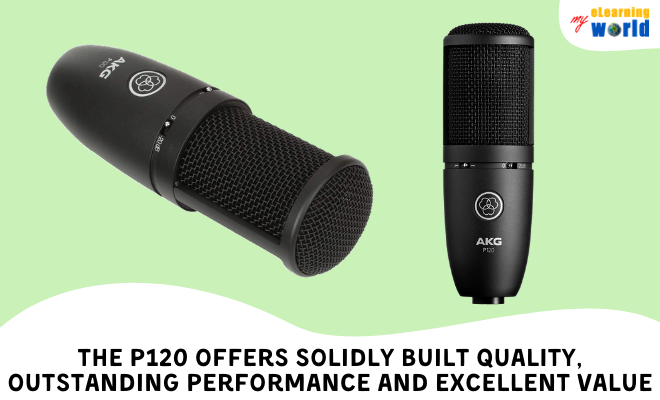
Best for: This cheap microphone is suitable for professional recording studios and home studios. Works to record voice-overs, vocals, and instruments.
This video, produced by Archie Beatz, shows how he tests the AKG P120 in his tricked-out home studio. He has many microphones, and he knows what he is talking about.
The reviewer shows how the cardioid polar pattern works, which is a heart-shaped pickup pattern. The model captures more sound when speaking into it than when speaking on the side and even less when he speaks at the back. This microphone is his favorite budget choice. He likes it more than his other mics, some of which cost up to $3,600. For a professional that could use anything he wants, that is an excellent recommendation for one of the best cheap microphones out there.
Buying Options
Large-Diaphragm Condenser Microphones under $100 with USB
This category is represented by wide variety of devices to choose from. There are models for recording vocals and musical instruments, and there are microphones for streamers and podcasters. I have chosen three of them.
4. Blue Snowball
The Logitech Blue Snowball USB Microphone is a game-changer when it comes to sound quality. Its 2-capsule design ensures that your voice has that exceptional presence and detail, making professional-level recording attainable even from a home studio. The microphone offers multiple pickup patterns, including cardioid for focused recording and an omnidirectional setting that’s perfect for immersive conference calls. Its stylish retro design is not only aesthetically pleasing but also functional.
I also love its plug ‘n play feature, allowing for quick and hassle-free setup on both Mac and PC. And for those moments when you’re dealing with louder audio sources, the -10 dB Pad ensures clarity without distortion.
Whether you’re diving into podcasting, streaming, or just need a reliable microphone for recording course content, the Blue Snowball is a budget-friendly yet high-quality choice.
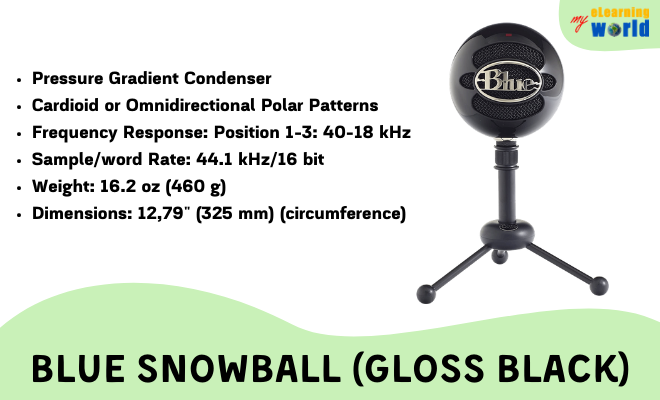
Features
Blue Snowball has two capsules. This allows it to have different pickup patterns. It is very easy to use for those recording using a Mac or a PC. All you have to do is take it out of the box, assemble the included desk stand and shock mount and plug it into your computer using the included USB cable.
Killer feature: The ability to switch between an omnidirectional and cardioid polar pattern.
Pros
- Plug and play for both Mac and PC with no software driver download required.
- USB 1.0 or 2.0 compatible with connector cable included.
- Gets its power from the six-foot USB connector cable.
- Stand and shock mount included.
- Handles vocals and music recording well and suitable for podcasting.
Cons
- The body is plastic.
- It is difficult to avoid recording noise transferred by desk vibrations.
- The omnidirectional setting adds tinny EQ to the sound.
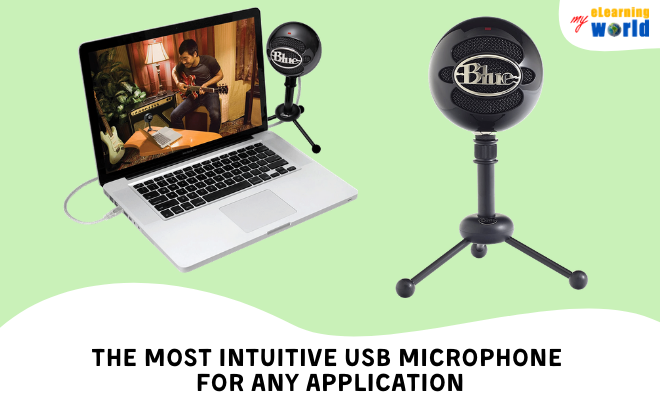
Best for: Podcaster or someone who make voice-overs using computer software for recording and editing.
If you’re looking for the best cheap microphone for creating YouTube content check out this article.
This video is a review by Podcastage that tests the sound quality of the model for voice, vocals, acoustic guitar, and electric guitar.
The reviewer changes the settings to show the difference between using this mic on the cardioid pickup pattern setting and the omnidirectional setting. He shows what the sound is like speaking directly into the microphone and from one, two, and three feet away. The reviewer says the cardioid pattern sounds natural and full. He thinks the omnidirectional pattern sounds tinny and adds too much noise. He does not think the omnidirectional setting is usable at all.
Buying Options
5. Samson Meteor Mic
I really like the design of the Samson Meteor Mic. It is very compact and yet powerful at the same time. This device is perfect for any audio recording situation. Just extend the legs, put it on a table, adjust the angle, connect the USB cable to your device, and you are good to go. It is a terrific choice for podcasting from any place that you conduct an interview.
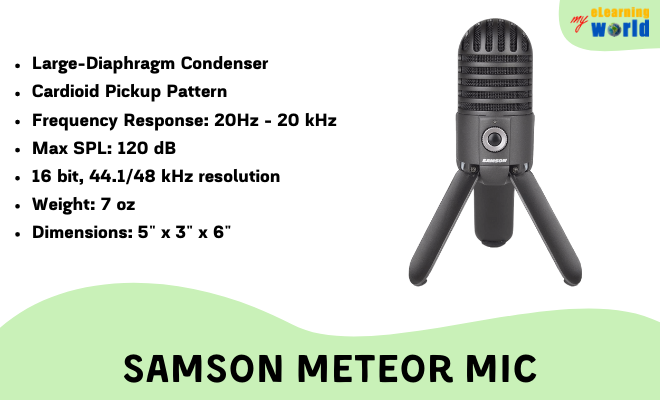
Features
The Samson Meteor Mic has a cardioid pickup pattern. It has on-microphone control to adjust playback volume and a handy mute button to cut off the mic recording easily. It comes with a USB connector cable that offers plug-and-play compatibility with no software drivers to download. It works with any computer equipment or audio interface devices that recognize USB audio inputs. It works with computers, laptops, tablets, and some smartphones.
Killer feature: Compact foldable legs to use for a stand.
Pros
- Frequency response 20 Hz to 20 kHz
- Large 25 mm diaphragm condenser
- 16-bit, 44.1/48 kHz resolution
- Built-in headphone jack on the device for zero-latency monitoring.
- Comes in black, chrome, and black/red colors
Cons
- Loose USB cable connections may cause a clicking sound when recording.
- Some customers complain that it breaks after about three months that is not covered by a warranty.
- If you need tech support from the manufacture it is very difficult to get help.
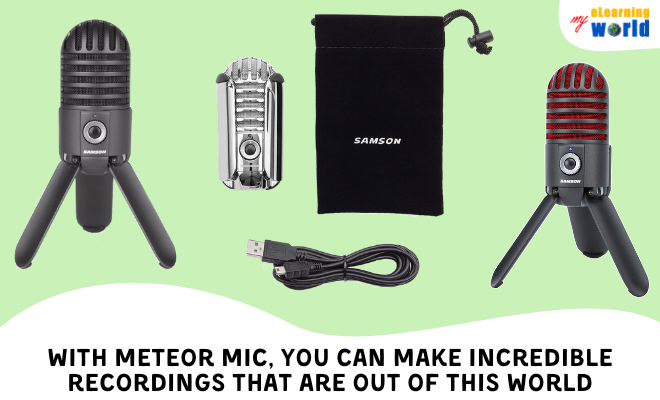
Best for: This model is a good choice for those who need a compact portable device that is easy to carry, setup, and use.
This is a product overview video produced by Samson Technologies, which is the manufacturer of the Meteor.
The presenter points out that this device is die-cast metal with an all-in-one design that includes the product and its stand as built-in fold-back legs. It is about hand-sized when the stand legs are closed and opens up to be about twice that size with the legs extended. The legs allow the microphone to be adjusted at any level on a desk. This model also can connect to a stand. It has a very large 25mm capsule, one of the largest available for a USB mic.
Buying Options
6. Razer Seiren X
Razer Seiren X is designed to use for live streaming podcasts and comes with a desk stand.
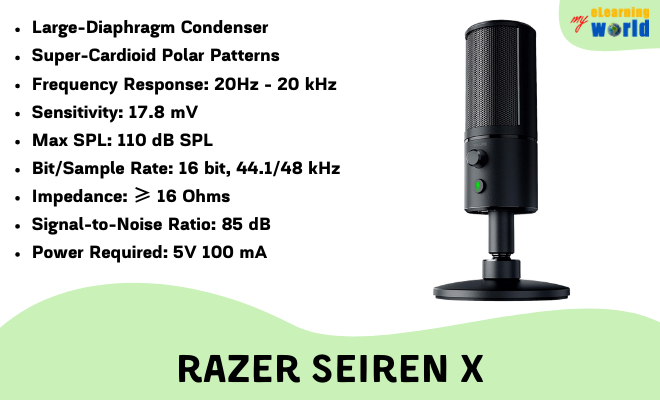
Features
This model has a built-in shock mount to reduce the sound of any vibrations or bumps from being recorded. It also has built-in noise reduction and a supercardioid pickup pattern. This eliminates most of the background noise, which is perfect for live-streaming audio. It offers zero-latency monitoring without any annoying delay or echoes.
Killer feature: The supercardioid pattern only picks up sound directly in front of it.
Pros
- Made from durable, yet lightweight, anodized aluminum.
- Recommended by Twitch streamers and gamers.
- The compact form factor makes it easier to take it along.
- Has a mute switch and volume controls on the device.
Cons
- There are no markings for the volume level so that take guessing where it is set.
- The Seiren picks up the keyboard clicking when set next to a keyboard on a desk.
- The supercardioid pickup pattern requires being very close to the mic.
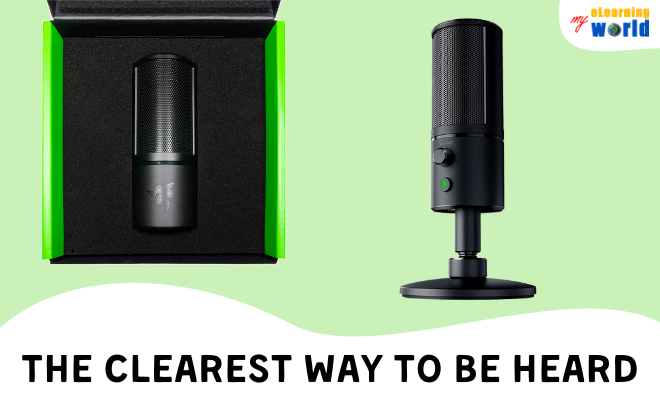
Best for: This product is designed for gamers and live streamers.
This review video is produced by DetroitFury, who is often reviewing Razer gaming products.
It is made to be a direct competitor to another budget microphone, Blue Yeti. It works for gamers with minimal setup, just plug and play. The one problem is that when placed near the keyboard on a desk, it will easily pick up the keyboard clicking. It comes with an adjustable stand and a USB cable. The reviewer compares the Seiren to Blue Yeti. It does not have any markings for the mic volume settings, so that is not easy to work with. The reviewer likes Razer Seiren X for its lower price and compact size.
Buying Options
Small-Diaphragm Condenser Microphones under $100 with XLR
Small-diaphragm XLR mics are better for recording instruments in your studio.
7. AKG PERCEPTION 170
AKG PERCEPTION 170 is designed to be used to record instruments such as drums, acoustic guitar, and strings.
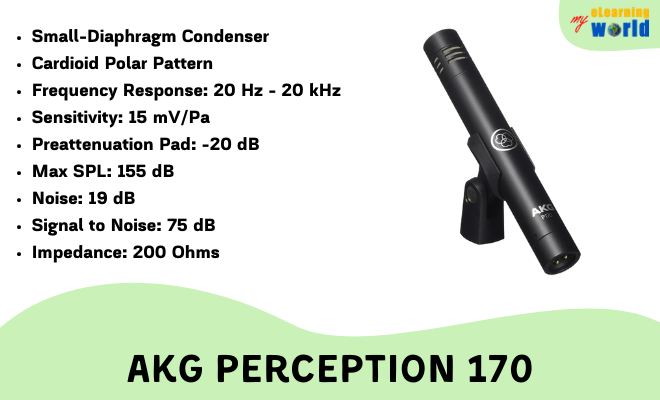
Features
The AKG Perception 170 is built to withstand heavy-duty use in a recording studio. It has a switchable attenuation pad for help in high SPL situations and can handle volumes up to 155 dB. Many audio engineers like to use these microphones to record drums, snares, high-hats, and cymbals. Its thin body makes it easy to mount on an arm stand and place it exactly where you want to record the sound.
Killer feature: Professional quality mic that is good for overheads.
Pros
- The P170 is lightweight with a compact design.
- It has a rugged metal body.
- Cardioid pickup pattern reduces background noise.
- Not sensitive to feedback sound.
- Compares to the legendary AKG C451 B.
Cons
- Best used for recording instruments.
- Requires a phantom power source.
- Requires an XLR cable (sold separately)
- Lousy customer service from the manufacture in China.
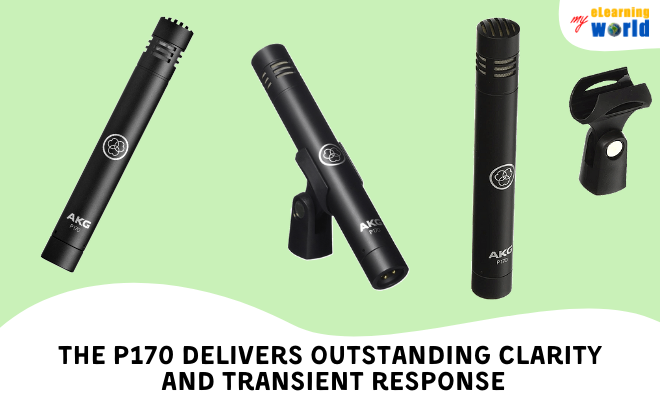
Best for: This model is for studio recording of instruments.
This video produced by CaneMajor reviews the AKG Perception 170 with its 12.5 mm diaphragm and thin body. This style is commonly called a “pencil” microphone.
The reviewer says the use of this device is to directly record the sound of an instrument that is not run through an amplifier. Every instrument has a location where it produces the best sound. The compact narrow-body style allows it to be placed on a stand and positioned in a place where it can capture the best sound emanating from different instruments. He shows how it is used to record different types of flutes.
Buying Options
8. MXL 770
MXL 770 is professional-grade mic at a budget price.
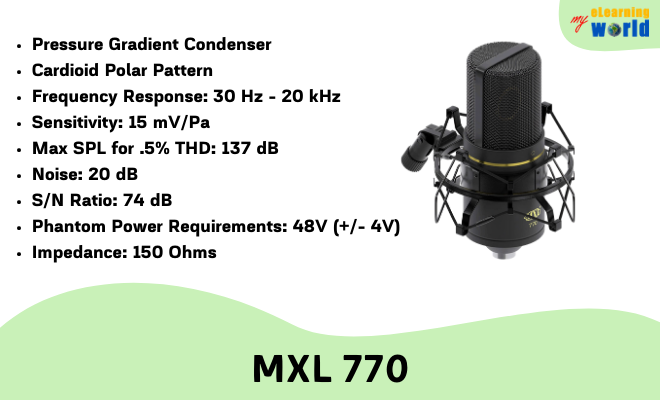
Features
This condenser mic has a 20 mm gold-sputtered (six microns) diaphragm, which helps it capture a smooth high-end and solid bass with a frequency range of 30 Hz to 20 kHz. It has a nice cardioid pickup pattern. The sound can be adjusted with a –10dB attenuator switch and a high-pass filter.
Killer feature: The price makes this product worth considering for its performance.
Pros
- Build quality is solid.
- Comes with a durable plastic case with fitted foam.
- Shock mount with extra elastics included.
- A stand adaptor and XLR cable is included.
- Has a bass roll-off switch and a -10dB pad switch.
Cons
- Requires phantom power.
- Shock mount is wobbly.
- Picks up some background noise.
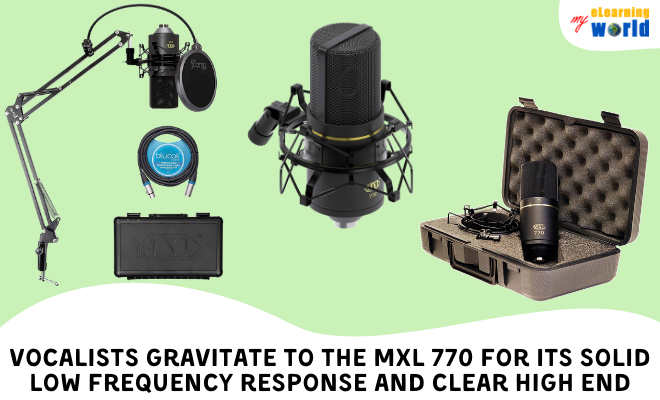
Best for: This is an all-purpose condenser microphone that can be used for voice-overs, vocals, and recording instruments.
This video is another review from the Audio Hotline where you can hear the opinion of an audio nerd about the MXL 770.
The reviewer gives many audio tests using his voice if you can stand listening to him ramble on about penises, singing off-key, and other nonsense. He shows how it sounds like if you use some EQ and sound compression. He plays guitar terribly. I keep watching his reviews because the information is good, while I wonder why he has over 11,000 subscribers on YouTube. There must be audio nerds out there who like his stupid jokes.
Buying Options
Small-Diaphragm Condenser Microphones under $100 with USB
For the most part, these mics are compact and easy to be portable.
9. Samson Go Mic
The Samson Go Mic is the ultimate portable model. It is tiny and comes with all the accessories you might need.
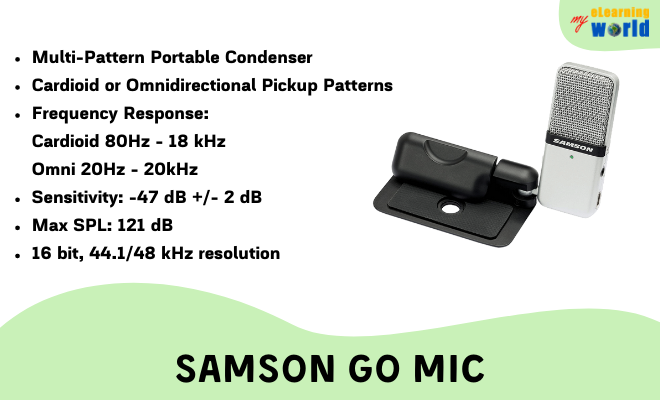
Features
This microphone is small enough to fit in your hand. It has three choices of polar patterns to use for recording. A green light shows on the front of the model when the recording level is decent, and a red light shows when the sound is being clipped. It is plug-and-play compatible with a Mac and a PC with no software driver installation required.
Killer feature: The choice of pickup patterns are cardioid, cardioid at -10 dB, and omnidirectional.
Pros
- Decent quality with a mixture of strong plastic parts and metal.
- Comes with a foldable clip that also serves as a stand.
- Very compact.
- A zippered case is included.
- Shows a red light as a warning when audio clipping is occurring.
Cons
- The weight of the device causes it to move when using the clip as a stand on a table.
- Comes with a mini-USB connector instead of the more modern micro-USB connector.
- Works better with a pop filter.
- The omnidirectional setting picks up lots of background noise and echo.
- Low end response misses some of the bass frequencies.
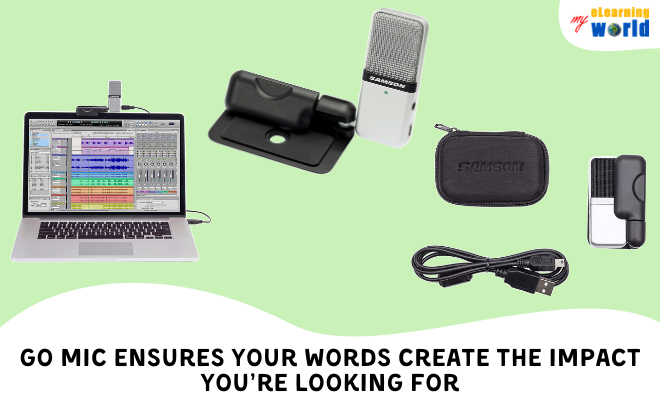
Best for: This product is an improvement over the built-in mics found in laptops and still is small enough to be portable.
The video is produced by Pert von Panda, and he gives a very simple overview of Samson Go.
The review is quite funny because Peter says “carrotoid” instead of cardioid, so I guess this device has a setting to record orange vegetables?:) He also does not know that this model has three pickup pattern settings, which are cardioid, cardioid at -10 dB, and omnidirectional. At least you can be inspired if someone as good as Peter can use this model to make nice-sounding podcasts, you can too.
Buying Options
10. Rode NT-USB-Mini
Rode NT-USB-MINI is a small adorable device that looks like the baby of other Rode products.
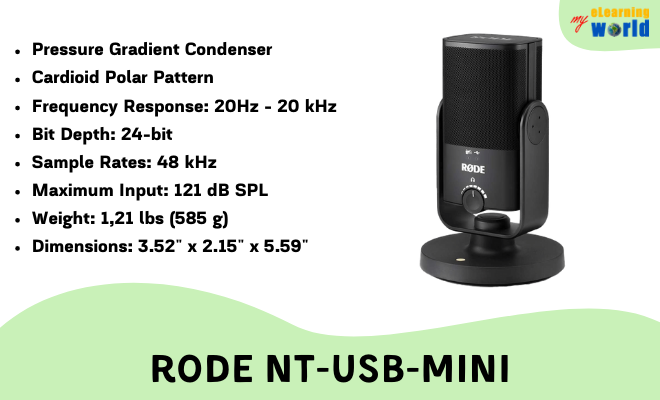
Features
This device is designed to record directly to a computer or a tablet. It is easy to use by placing it on a desk and plugging it into a USB port on your laptop. Works with a MAC, PC, and tablets.
Killer feature: This model is good for podcasting, gaming, and even vocals.
Pros
- No special external power is needed, simply connect it with the included USB cable.
- It is plug-and-play with no software to download or install.
- Comes with a magnetic desk stand that is detachable
- Has a built-in pop filter.
- Has a built-in studio-grade monitor amp for headphones with zero latency and volume control.
Cons
- No shock mount option.
- Included stand is very short.
- Easier to use if mounted on a boom arm (sold separately).
- The mic gain setting needs to be set in the audio recording software.
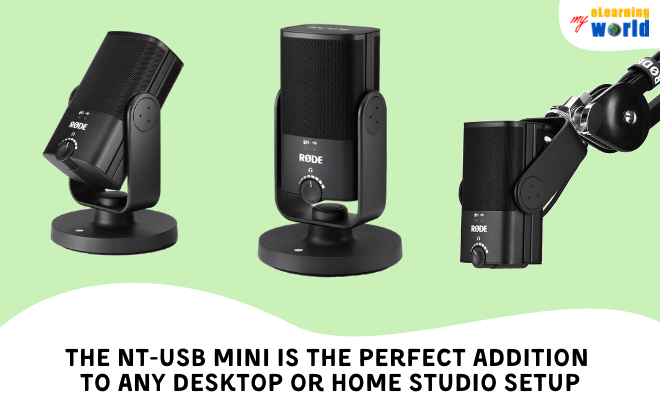
Best for: The NT-USB Mini is terrific for podcasting.
This review video produced by Sanjay C compares Rode NT-USB-Mini to a cheaper choice costing around $37 and to a much more expensive one that costs over $1,500 to see if the recording of the vocals is noticeably different.
The reviewer compares Rode NT-USB-Mini to the cheaper FIFine and the super expensive Peluso P12. He uses a song from Bruce Springsteen that he plays back with effects on the vocals and with a dry sound. The sound of the Rode NT-USB-Mini was quite good. It was better than the cheaper one and stood up well against the more expensive pick, although you can tell the difference. You get what you pay for.
Buying Options
11. Blue Yeti Nano
The Blue Yeti Nano is a USB plug-and-play Mac and PC compatible microphone.
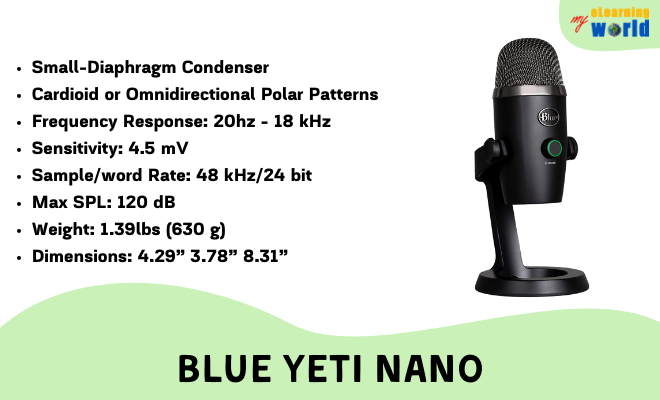
Features
It comes with a desk stand. It has a no latency headphone output jack on the mic, a headphone volume control, and a button to mute it. The mute button shows a red light when the device is muted and a green light when it is active.
Killer feature: This model is perfect for desktop use and only weighs 1.4 pounds.
Pros
- Offers both cardioid and omnidirectional pickup patterns.
- Compatible with a shock mount or boom arm.
- Comes in five colors.
- Comes with a desk stand
- Has a one-year limited warranty
Cons
- The tilt knobs on the stand do not tighten down well.
- The Yeti Nano can be dented by transporting it on the stand if swivels and it hits the stand.
- Mic gain is only controllable by the audio recording software.
- Does not have micro USB connector just mini USB.
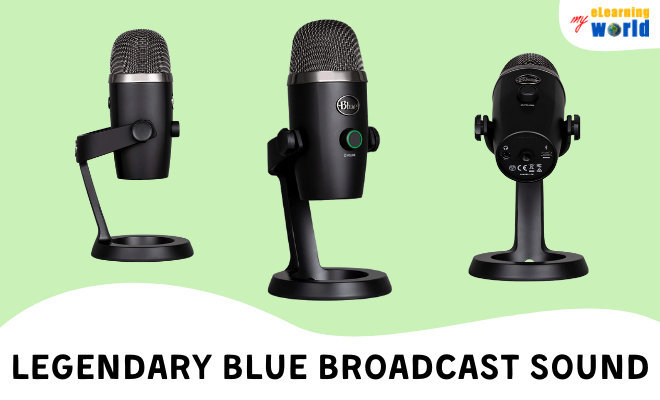
Best for: This product is very popular for doing podcasts where the model is shown because it is an attractive model.
This video produced by MrMobile compares the older version of Blue Yeti and the newer Blue Yeti Nano.
He likes it and tells how he used it at a trade show to record podcasts in poor quality audio environments. He says the model has very good recording quality for the price. He likes the Blue Yeti Nano because it is smaller than the older Blue Yeti and yet performs just as well and is very simple to use.
Buying Options
Best Cheap Dynamic Microphones Under $100
Dynamic mics can handle intense sound levels, such as recorded a live rock concert. They are rugged and built to withstand lots of abuse. A musician can yell into them, drop them, swing them around their head on a cable, and they will usually still work.
Dynamic Microphones under 100 with XLR
XLR dynamic microphones are widely used by musicians and live performers.
12. Shure SM58-LC
The Shure SM58 is a music industry favorite for live performances.
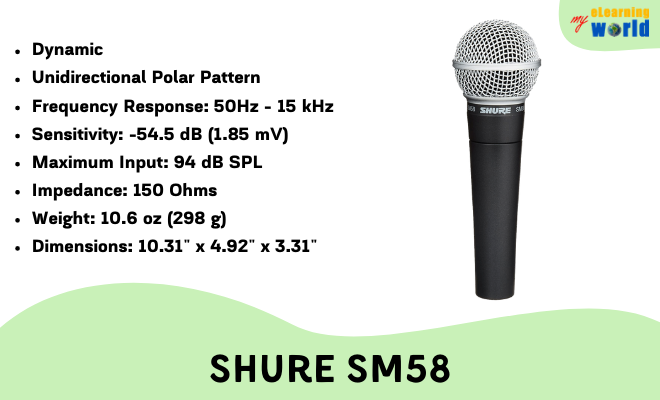
Features
This model can take extreme abuse and continue to work. There are videos online of using one as a hammer and one being run over by a bus, and still, it works afterward.
Killer feature: Every out-of-control rock star in the world has abused this microphone. It can take it.
Pros
- Has an all metal body and all metal grill.
- Comes with a clip and a 5/8 to 3/8 inch stand adapter.
- A zippered carrying case is included.
- Cardioid polar pattern.
- Great value for the price.
Cons
- Not good for delicate high-end sound due to frequency response upper limit of 15 kHz.
- Has a low sensitivity.
- Best sound comes from being right on top of it.
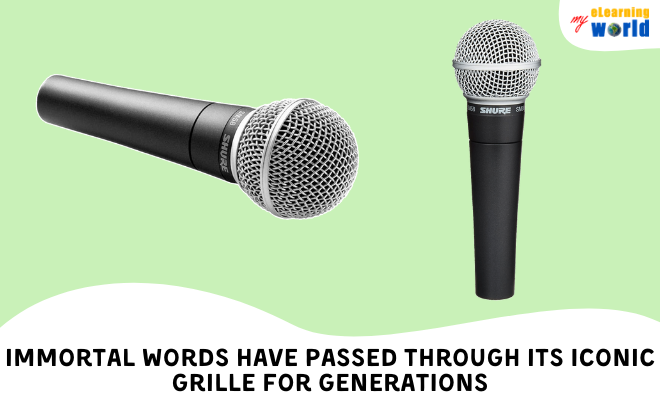
Best for: This all-purpose product is good for almost every live music performance and live recording use.
This video review by the Podcastage says that Shure SM58 is the favorite mic he uses.
The reviewer likes Shure SM58 because it sounds great when recording guitar and vocals and has background noise rejection. He likes this device so much that he owns four of them. He recommends that every recording studio have at least one. He demonstrates vocals, acoustic guitar, and electric guitar.
Buying Options
13. Sennheiser E835
Sennheiser E835 is another very rugged dynamic mic that is a direct competitor to Shure SM58 and AKG D5.
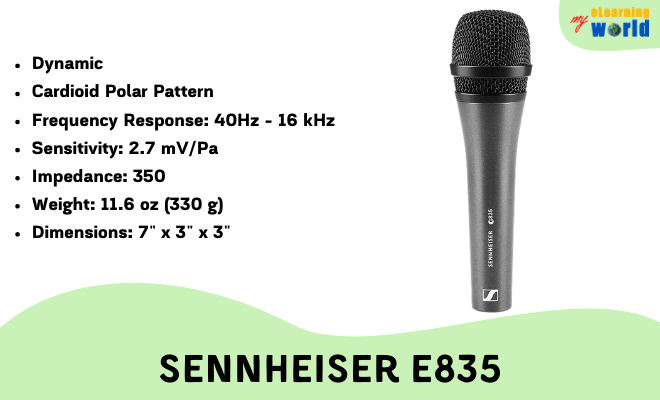
Features
A helpful feature of this model is its uniform frequency pickup pattern that maintains signal quality when a singer moves on and off-axis during a performance. It has a low proximity effect that allows the E835 to create clear bass and vocals when a singer is close to or further away from the microphone.
Killer feature: This product has an outstanding 10-year warranty covering all parts and labor.
Pros
- Cardioid pickup pattern.
- Produces a consistent sound quality.
- Can handle high sound levels.
- Optional on/off switch.
- Superb feedback rejection.
Cons
- Slighty heavier and larger than Shure SM58.
- Not the best choice for ballad singers or those with softer voices.
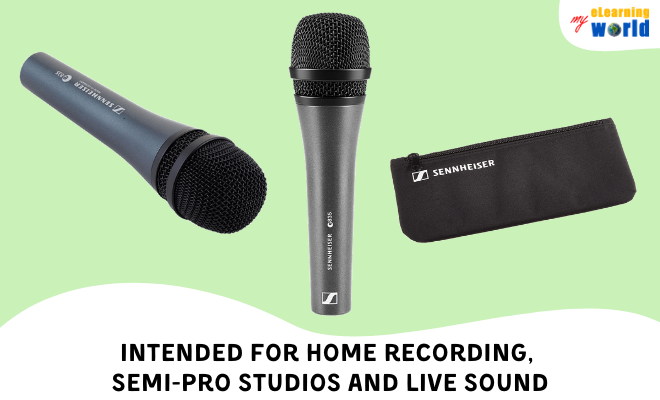
Best for: This model is made for vocalists giving live performances.
This review video from SonicSenseProAudio makes the comparison between the most popular dynamic microphones that cost around $100 each.
The reviewer compares Shure SM58, Sennheiser e835, AKG D5, and AUDIX OM2 to see how they stack up against each other. You can hear a female vocalist using all four mics for a side-by-side comparison with no EQ or other treatment of the recorded sound.
Buying Options
Dynamic Microphones under $100 with XLR+USB
XLR+USB microphones let you choose to use them with an audio interface or plug it directly to your computer.
14. Samson Q2U
The Samson Q2U, with both XLR and USB outputs, allows both digital and analog sound capture in a single device.
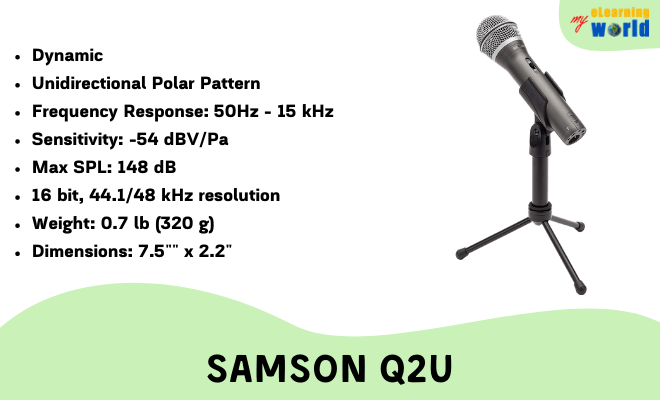
Features
This is a popular low-cost model that can be used for live analog recording and digital recording. The USB connector is plug-and-play compatible with a Mac and PC. The XLR connector works with an audio interface or a mic preamp.
Killer feature: This model is the best USB mic recommended for Garageband users.
Pros
- Connects directly to a computer using USB or to an audio interface that accepts XLR connectors.
- Come with a clip, windscreen, and a desk stand with an extension.
- An XLR and USB cable is included.
- Both signal outputs can be used for a live performance and making a digital recording at the same time.
- The Q2U has a 1/8 inch (3.5 mm) headphone output with volume control to directly monitor the sound.
Cons
- Using a USB mic allows only one device at a time to be used for digital recording.
- To record more than one mic output at the same time requires using an audio interface (sold separately).
- There are latency problems when using USB and Bluetooth connected speakers.
- Using the on/off switch causes a clicking sound.
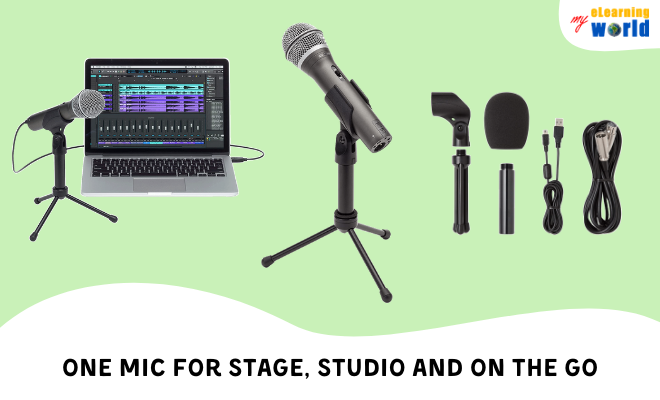
Best for: This product is an excellent choice for those that need to sometimes record digitally and other times record by using an analog signal.
The video review by EposVox describes the Q2U as his most favorite model.
The reviewer opens the box and shows the accessories. It has a built-in noise gate that reduces background noise to almost zero. He demonstrates how the air-conditioning sound in the background is not picked up when he is doing voice-overs.
Buying Options
15. Audio-Technica AT2005USB
The Audio-Technica AT2005USB is a decent dynamic mic that is not as rugged as some others in this category that cost a bit more.
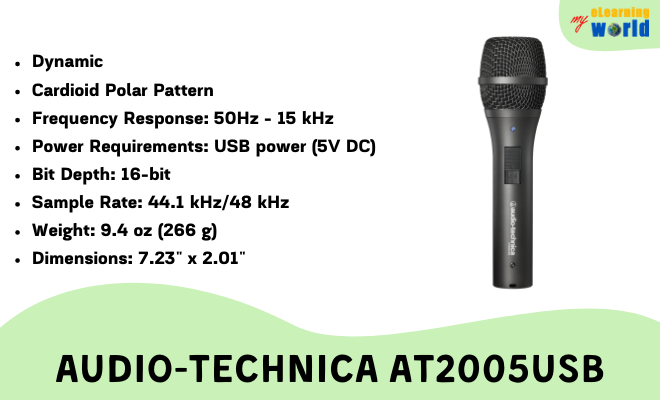
Features
This model is a good choice for voice-overs, podcasts, and screencasts because it is easy to use right out of the box.
Killer feature: The AT2005 can be used as a digital USB mic or analog XLR one.
Pros
- Offers a plug-and-play digital USB connection to a computer.
- A simple tripod desk stand is included.
- Comes with a USB and an XLR cable.
- The product has a built-in headphone jack with headphone volume control.
- Comes with a fake leather carrying pouch.
Cons
- This choice is not good if you want to hide the microphone and not show it in a video of the speaker.
- The stand is not height adjustable.
- The stand has plastic threads and you must be careful you don’t strip them.
- Has a proximity effect, which adds bass to the vocals when getting too close.
- Best to use with a pop filter to remove plosives from the sound.
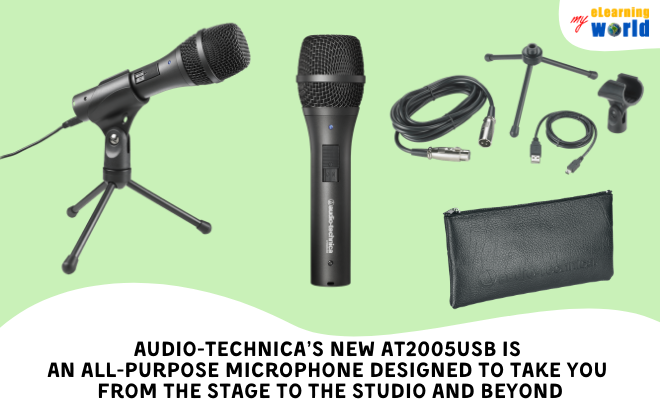
Best for: This is a good starter mic for voice-overs and podcasts.
This review video produced by Curtis Judd demonstrates how the AT2005USB sounds when used in a room with terrible acoustics.
The reviewer shows how to use it and how you need to get close to the device. He shows a test with a voiceover that is recorded using the USB connection when compared to the XLR connector with an audio interface.
Buying Options
16. Audio-Technica ATR2100x-USB
Audio-Technica ATR2100x-USB is a newer model of the ATR2100.
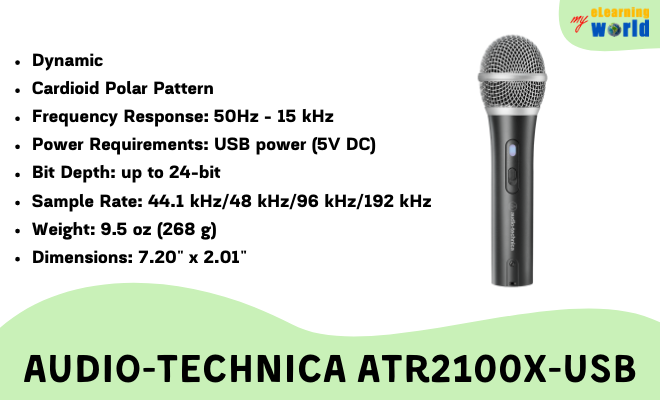
Features
The major upgrade is that this new model works with USB-C, but that is pretty much the only change of significance from the older model.
Killer feature: This product has both a USB-C digital output and XLR analog output.
Pros
- Durable and strong construction.
- On/off switch on the device.
- Built-in headphone jack and headphone volume control on the nicrophone.
- A sturdy, folding legs, tripod, desk stand is included.
- Comes with three cables” USB-C to USB-A, USB-C to USB-C, and XLRF to XLRM.
Cons
- A little heavy for a handheld device, weighing 1.6 pounds.
- The stand it comes with is made from cheap plastic.
- Needs a windscreen or pop filter to record voice-overs properly.

Best for: This is a good choice for those with devices that have a USB-C input.
This video review is produced by Pat Flynn. He compares an older model from this series that is now discontinued replaced with this newer model.
He tries to use the cheap stand, and he hates it. He twists it and breaks it easily. Then, he breaks it again. He does not want to use the stand anyway, so he does not care about it. He then records a test voice-over with it using Garageband software. He is not that impressed with this choice.
Buying Options
Best Cheap Ribbon Mics
Many ribbon microphones are very expensive, but there are models that can fit your budget.
17. MXL R144
MXL R144 adds a warm jazz-like sound to vocals and recorded acoustic guitar.
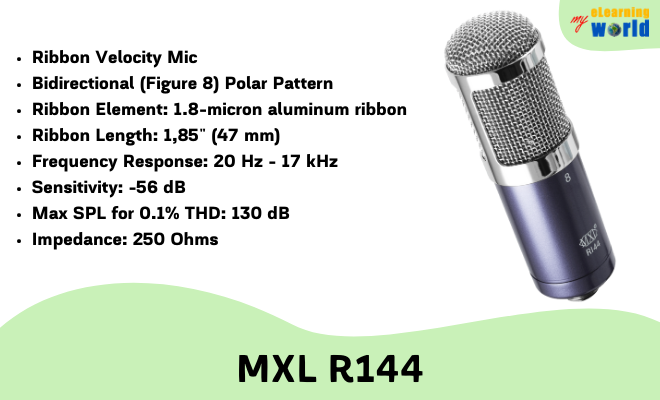
Features
This is a specialty model, best used for creating vintage-like recordings. It is good for capturing special darker tones and blending the sound with other models.
Killer feature: This is a cheap entry-level ribbon mic, so if you break it, you won’t go bankrupt.
Pros
- All metal body and metal mesh.
- Comes with a shock mount.
- Add warm tones to vocals.
Cons
- Ribbon microphones are very fragile and easy to break.
- A plosive can break it.
- Dropping it can break it
- Using phantom power can break it.
- Picks up background noise from vibrations.
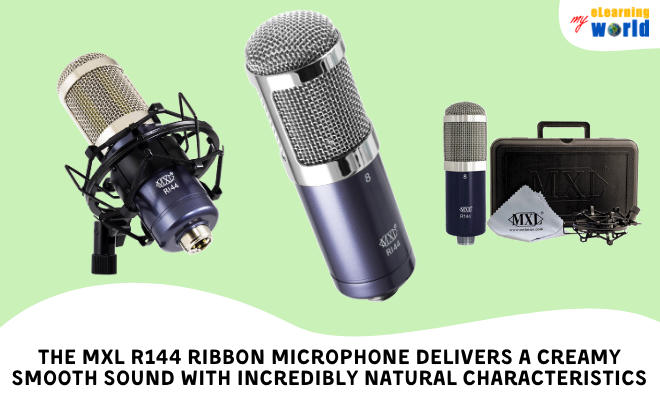
Best for: This type of microphone is only useful for those who can take extremely good care of a mic.
This video review is produced by Podcastage.
He demonstrates how the R144 sounds in a treated sound room and an untreated room. He records guitar and vocals. He recommends blending a ribbon mic with a recording made by another dynamic microphone.
Buying Options
Must-Have Accessories for Your Budget Mic
Here are some other must-haves for your cheap microphone to be able to use it properly.
Mic stands
A stand is necessary to hold the microphone in the proper position to capture the sound.
Here are three choices of mic-stand styles:
- Arm Stand: the Neewer arm stand is a suspension-boom scissor-arm stand.
- Floor Stand: the Samson MK-10 floor stand is a classic tripod style that is collapsible.
- Desk Stand: the On-Stage DS7200B desk stand is compact, adjustable and sturdy.
Other Items
- Shock Mounts: the Neewer shock mounts are used to reduce unwanted noise from vibrations.
- Pop Filter: the Neewer pop filter helps reduce the unwanted sound of plosives.
- Audio Interface: the Focusrite Scarlett audio interface can be used for analog recordings.
Useful Resources
- Microphone polar patterns
- What is a dynamic microphone?
- 10+ statements on condenser microphones versus dynamic mics
- The best studio headphones for recording at home
- The best voiceover microphones
- How to record a voice over demo reel at home
- How do wireless microphones work?
A Final Word on the Best Budget Microphones
Hopefully, you’ve learned that you don’t necessarily have to pay an arm and a leg for a decent microphone. There are some great budget microphones out there in just about every category and for basically every application imaginable.
It’s quite common to have at least one device in each of the four general categories so that you always have an adequate mic on hand if you plan to record different types of things.
Have any more questions about our guide to the best budget microphones under $100? Let us know by commenting below.

